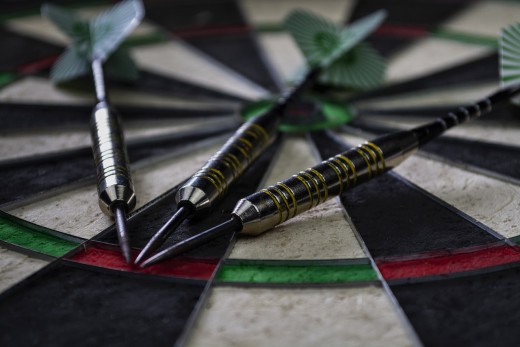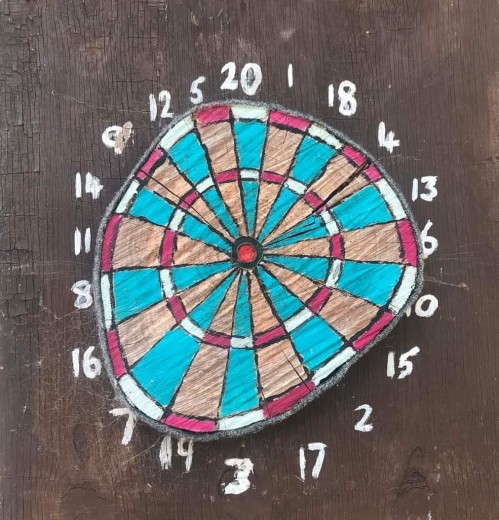January 1, 2004
Column 153
A Whole Lot of Bits about Something
You never quite know what to expect when you pick up a book about darts.
We’ll, actually you pretty much do. That’s the unfortunate thing.
There is a boring, monotonous, similarity — a predictable, formulaic, uniformity — to many of the darts books in the marketplace. There’s a chapter about history. A bit about equipment. Another bit about how to hang a board. A bit about technique. A bit about practice. A bit about out shots. A bit about different games. A bit about the lingo of the sport. UGH!
Yep, it’s usually the same old, same old. A whole lot of bits about NOTHING.
Disconnected.
Unexciting.
Forgettable.
So as Delta flight 2002 edged its way out of the gate at Tampa International Airport I wasn’t expecting much as I leaned back in my seat and opened the cover of the newest addition to my collection of books about our sport.
Off I flew.
And so did time…
Five hours later, as what’s left of Mount St. Helens appeared outside my window and the 747 began its descent towards Seattle I was pleasantly surprised to find myself turning the final page of George Silberzahn’s newest offering: “How to Master the Sport of Darts.”
Silberzahn has produced a winner here. He’s figured out a fresh way to present old but important subjects in a very readable fashion. And then, for extra and extremely effective measure, he reinforces his main messages by yielding more than half of the space between the covers of his manuscript to first-person bits of wisdom from some of the legends of the sport of darts in America.
Silberzahn has a way with words. He paints pictures. And his pictures work.
Here are just two examples:
“It was a clear steel-blue day. The firmaments of air and sea were hardly separable in the all-pervading azure; only, the pensive air was transparently pure and soft, with a woman’s look, and the robust and man-like sea heaved with long, strong, lingering swells, as Sampson’s chest in his sleep.”
Oops. Sorry. That was from Moby Dick. Talk about getting stuck with a really big dart…
Here’s Silberzahn on concentration and aiming: “There is a difference between focusing your concentration and trying to aim: focusing helps and aiming hurts. You can’t aim a dart anymore than you can aim a ball you throw. You can focus your concentration, thus the landing point of your dart. Picture a laser beam from your eyes to a spot within the bulls-eye. Got the picture? Okay, what you are going to do to “aim” the dart is to draw the dart back toward your eye along the laser beam, pause ever so briefly and thrust it forward along the laser beam, directly toward the spot at the other end, reaching into that spot.”
On spot shooting in particular: “Spot shooting requires locating a shadow, tuft, indentation or something of the like that catches your eye. Locating this spot requires concentration. If you shoot a dart at the whole board without looking at any specific part of it, your margin of error is the whole board. If you look at the whole frame, your margin of error is the whole frame and half of the adjoining ones. If you look at the whole triple, your margin of error is the whole triple and the area adjacent to the triple. If you look at only a very small spot, your margin of error is reduced to its lowest and your accuracy increases.”
Okay, Silberzahn’s no Melville. And I’m no Dave Barry.
But this is darts, damnit. Not the classics. Not Pulitzer humor.
Silberzahn’s prose gets the job done damn well! Even if mine doesn’t.
What Silberzahn has done — and he’s pegged it smack in the triple twenty — is take his pen and create crystal clear images that will impart a lasting message to any level of darter. In chapter after chapter Silberzahn steps to the lectern and shares his knowledge in a manner the reader can almost touch and feel.
(And make no mistake about it: Silberzahn has the knowledge. This is an expert darter who averaged more than fifty on an American board and, once he switched to a bristle board, at one time or another put the whoop-ass on everybody in the very next paragraph.)
Then, as if to say “Hey, if you still don’t get it, don’t take it from me — listen to these guys,” he hands a big, fat pad of paper and a brand new pen to nine of the most accomplished darters ever to step to the line in America: Joe Baltadonis, Conrad Daniels, Frank Ennis, Ray Fisher, Bob Theide, Jerry Umberger, Danny Valletto, Helen Scheerbaum and Julie Nicoll-Jennings.
Sadly, many of these names are unfamiliar to the mass of those involved in darts today. But not one of them is unknown to the likes of Eric Bristow, Cliff Lazarenko, Dennis Priestley, Phil Taylor, John Part and so many others. In their day every single one of these American darters has taken the best anybody in the world has had to offer — and come out on top. Some of them are still winning today.
Sure, there’s a book or two (or three) out there by John Lowe. Jocky Wilson’s got a story on the shelves. So does the late Leighton Rees. And Bristow. Even Phil Taylor is due to publish soon. But nowhere in darts literature can a reader find between the covers of just one book the array of advice — and vivid career reminiscings — the likes of which Silberzahn has assembled.
To the extent Silberzahn has a way with words so, it turns out, do each and every one of the legends he features. I count several of them as friends and was struck with how alive their writings were. I was mesmerized. As I turned the pages and shared their memories and emotions, war stories and regrets, and absorbed their advice, I felt as if we were sitting across from each other, sipping a beer and contemplating a game.
Lessons I’ve already learned made even more sense.
From Nicoll-Jennings, on the advantage of weighted darts: “If you throw a ball of paper into a trash can, if you don’t throw it hard enough it either won’t make it to the trash can or it will float from left to right, but if you throw a little pebble towards the trash can it will go exactly where you throw, it does not float, and that’s the difference between light and heavy darts.”
Daniels on technique: “I watched basketball players shooting fouls and thought about the comparison to my dart stroke. I wondered why a great basketball player would stand at the line and bounce the ball a few times before he shoots it? These are the guys that are the best, the ones who do that. The ones who just go up there and throw it aren’t. I started a rhythm to my stroke by pumping my hand, slowly so I was already in my rhythm by the time I started to draw the dart back, rather than hold the dart out there and watch my hand shake. I saw that the biggest mistake that most dart players made was not enough extension of the arm, not enough follow through. I made sure my arm and hand ended up pointing at the target. When you watch a great basketball player that is exactly the way they do.”
Fisher on losing: “Whenever I’d lose I thought of it as a learning experience, a way to improve my game. I would get mad but I didn’t let it get to me. Losing made me mad but I didn’t say anything to my opponent. I’d go sit and get over it. You know, it happened, so it happened, you can’t worry about things like that because it won’t do any good.”
And Umberger on perhaps the most important lesson of all: “One thing I tell people about darts, is don’t do what I did, do what I say: practice. I was never ready for a tournament and if I had it to do over again I would have been. I won, but if I’d practiced I could have won more.”
Yep, George Silberzahn’s “How to Master the Sport of Darts” is crammed to the gills with the usual — but every message is presented in a uniquely refreshing and memorable way.
The book’s a whole lot of bits about SOMETHING.
You’ll find it impossible to put down.
From the Field,
Dartoid








